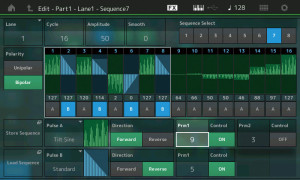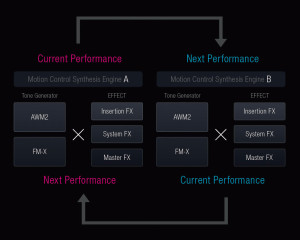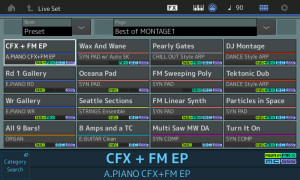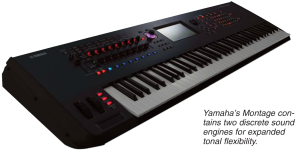Ahhhh, those folks at motifator.com! They have managed to access the high resolution images that accompanied the briefly revealed information on the Yamaha music production synthesizer pages. Thanks, folks. I’m sure that you will cruise over there to see all of the images. However, here are a few things that struck me.
The Motion Seq image is quite informative. As I suspected, the sequencer user interface has undergone a substantial revision. It is more “DAW-like” in appearance and operation. (Click on the images below to get full resolution.)
It’s also clear — from the other images at motifator.com — that arpeggios (ARPs) have not gone away. I’m sure that Yamaha wants us to focus on the new product features first, rather than reading about old news.
Seamless Sound Switching (SSS) effectively switches between two Performances (eight part maximum per Performance). The eight part limitation comes from the need to keep the currently playing voice and effects chain live in the tone generator while the second Performance parts are enabled. The elements and effect units assigned to the first Performance have to remain active and processing while the second Performance spins up.
I am very glad to see SSS as I often hold a chord at the end of a verse or refrain while bringing up a new patch. It’s hard to transition around the current sound cut-off while keeping a congregation in sync. (Worship musicians everywhere will rejoice.)
The snapshot of the voice selection page shows “Best of Montage” voices. Yamaha are clearly proud enough of the Rhodes and Wurlitzer electric pianos to include them in “The Best.” There is also an organ voice called “All 9 Bars!”. Oh, oh, this bodes well for those of us in need of good bread and butter sounds! Plus, I have got to play the bars. Still need to hear the rotary speaker effect…
It will be interesting to discover if Yamaha have continued to mine the SuperArticulation voices and technology in the Tyros and upper-end PSR arranger workstations. The Motif XF added an SA-inspired tenor sax and hopefully, the improved wooodwinds will offer more treats. Bring me an SA jazz flute, Santa. Please?! 🙂
I can’t wait to play this machine! Looking better all the time.
We shouldn’t forget about the software side. Steinberg have not been sitting on their hands. Plus, the Yamaha Mobile Music Sequencer (MMS) has only seen bug fixes in the last few releases. Shall we see a new version of MMS? What do Cubase and Cubasis have in store for us? Any new and cool apps?




